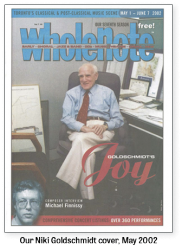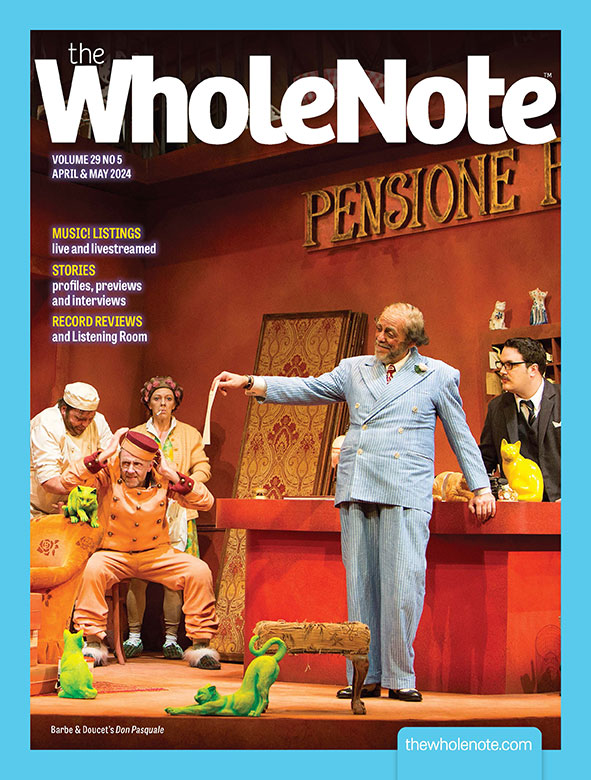On Music Making In Particular Places
Perspectives by incongruity 1
In this particular version of an ancient allegory, the Editor-In-Chief summons two scribes to his lofty perch and says, “Go forth and ascertain the health of the operatic art form in our realm during the months when shorts are shortest and the sun is at its highest in the sky.”
So off they go, and in due course they return and the one scribe steps forward and says:
“A peculiar thing happens each year around mid-May in this, the largest, busiest city of Canada: Toronto opera life all but shuts down, give or take an intrepid indie daring a short, early-June run. And the season stays shut until the latter half of September.”
“Aha!” says the Editor-In-Chief. “Thank you!”
Then the other scribe steps forward and says:
“It used to be that, come June, Ontarians had to leave the province to seek opera performances elsewhere. That’s not the case this summer, which is surprisingly filled with opera, especially with new ones.”
“Aha!” says the Editor-In-Chief. “Thank you!”
At this point, the Managing Editor, who has been observing all this with an almost imperceptible frown, steps forward: “They can’t both of them be ‘Aha!’” the Managing Editor says. (And the Senior Proofreader, who has also been observing all this, nods in almost imperceptible agreement.)
“Aha!!” says the Editor-In-Chief. “Thank you!”
Perspectives by incongruity 2
“Way to hedge your bets,” I thought at the time. If the global public does come to see how wonderfully cultural we are, mission accomplished. If, on the other hand, those of us who can’t afford plane and concert tickets get to take in some of the great art and culture of our time right here in our own backyard, then mission still accomplished!
(That being said, I will forever remain grateful for the opportunity to take in the Ex Machina/Robert Lepage production of Lip Sync at the Bluma Appel Theatre in 2009. It was worth every penny, at a time when pennies were still worth something.)
I’m quite sure, though, that this ambiguity of mission has not served Luminato very well over the years. “And if they still don’t get that it doesn’t serve them well, then it serves them right,” is what I would have said, right up until a few months ago. But methinks, as Andrew Timar intimates in his World View column this issue, there may be some hope on the eastern horizon.
The decision to tie Luminato’s fortunes to a single location – the decommissioned Hearn Generating Station in the eastern portlands represents for me, the recognition, finally, that the stated goal of attempting to turn the whole of downtown Toronto into a ten-day cultural wonder of the world has been as much of an exercise in futility as it would have been be to try to turn the outfield at the Rogers Centre into a world-class rose garden.
I don't know enough about the inner workings at Luminato to know whether this decision is a final virtuosic flourish from outgoing artistic director Jörn Weisbrodt. But bravo to someone for what is simultaneously an act of humility and outrageous grandiosity. “Hey guys, we’ve decided to think global and act local. So let’s go score us the biggest honking locale we can!”
How they go about getting us locals to go there in droves (so we’re eventually worth some global gawking at, while we play) is another question. But, I say this year, give them the benefit of the doubt. Go experience the potential of the place – imagine, for example, what a remount of Apocalypsis would have been like at the Hearn instead of the Sony Centre!
Lessons learned:
Here’s to Brian Barlow’s Jazz Van during the PEC JazzFest careening around the county, stopping to unload sounds of brass into the Quinte roadside air!
Here’s to the visionary individuals in places like Elora, Parry Sound, Clear Lake, Indian Springs, Stratford, the Beaches, and yes, even downtown Toronto, who looked at some particular place, thought of some particular time, imagined the music that belonged there, and did something about it.
Here’s to all our future musical places yet to discover!
Here’s to open air music in all our downtowns, little and large.
Here’s to getting to recharge our musical batteries over the summer so we come back in the fall with fresh ears!
Last print issue till September
We are done in print now until the beginning of September. So now’s the time to register, on the front page of our website, for our e-letter, HalfTones, which will publish June 15, July 4 and August 10, bringing you news, updated listings, contests and links to newly posted videos, audios, concert reports and more!
publisher@thewholenote.com





